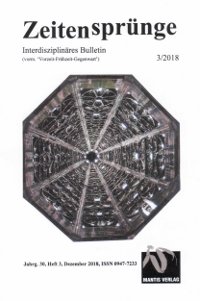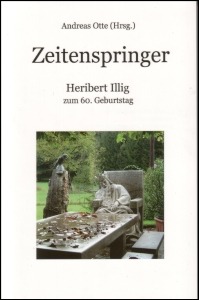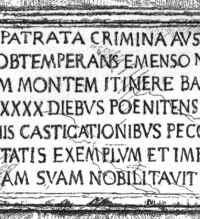“Welt am Sonntag”, 2. Januar 2000
Unsere Zeitrechnung beruht auf der Kalenderkorrektur von Papst Gregor XIII. Er hat 1582 im Kalender 10 Tage überspringen lassen, damit astronomische Situation und Tageszählung wieder übereinstimmen. Damit hat er aber nicht den Fehler korrigiert, der seit Cäsar (45 v. Chr.) im julianischen Kalender aufgelaufen ist, sondern nur den Fehler seit ungefähr 300 n. Chr. Und trotzdem liegt seitdem der Frühlingsbeginn (Äquinoktie) wieder auf dem 21.3. Mit falscher Korrektur zum richtigen Ergebnis!?
Die Spezialisten behaupten, dass sich Gregor auf das Konzil von Nicäa (325) bezog, weil damals der Kalender entweder korrigiert oder zumindest der Frühlingsbeginn auf den 21.3. festgeschrieben worden sei. Doch dafür fehlen die Belege; alle Argumente sprechen dagegen. Somit wäre der Abstand zwischen Cäsar und Gregor XIII. um rund 300 Jahre kürzer als bislang gedacht – gemäß meiner These sind drei Jahrhunderte erfundener Geschichte eingefügt worden.
Für fiktive Zeiten, die ich von 614 bis 911 ansetze, kann es keine realen Zeugnisse geben. Nun gelten diese Jahrhunderte ohnehin als “dunkel”, weil die geschichtlichen Überlieferungen ebenso dürftig sind wie die archäologischen Funde. So finden wir in keiner heutigen, ursprünglich römischen Stadt eine frühmittelalterliche Besiedlungsschicht; die zugehörigen Geschichtsquellen sind keines-wegs zeitgleich, sondern oft erst Jahrhunderte später verfasst worden; Hunderte byzantinischer Städte scheinen in dieser Zeit unbewohnt gewesen zu sein; die Funde im islamischen Spanien setzen keineswegs 711 mit der Eroberung ein, sondern erst im frühen 10. Jh. – und so fort.
So die These richtig ist, darf kein einziger Fund für eine Zeit zeugen, die nie abgelaufen ist. Deshalb waren die ihr zugeschriebenen Reste zu prüfen.
Von den über 1.000 schriftlich genannten Bauwerken ist kaum eines auch nur aufzuspüren. Die Aachener Pfalzkapelle als das berühmteste erhaltene Zeugnis aus dieser Zeit kann nicht ohne Bauhütte, ohne direkte Vorläufer und Nachfolger entstanden sein und gehört niemals – laut meinem unwiderlegten Beweisgang – in die “Dunkelzeit”. Die Lorscher Torhalle rückt von 770 oder 870 ins frühe 12. Jh. Die wenigen anderen Kirchen der “Karolingerzeit” lassen sich zwanglos den ottonischen eingliedern. Auch die “karolingische” Buchmalerei ist in Wahrheit ottonisch und aus diesem Grund kaum von den Kunstwerken dieser Zeit zu unterscheiden.
Fürs damalige Mitteleuropa sind Grabfunde am häufigsten. Aber sie können keineswegs absolut, jahrgenau datiert werden, sondern nur relativ. Die erkennbare Abfolge wurde aber nicht über rund 200 Jahre verteilt, sondern – der herrschenden Chronologie entsprechend – über mehr als 400 Jahre, womit ein scheinbarer Bevölkerungsrückgang im 6. Jh. und eine unerklärbare Bevölkerungsexplosion um 1000 n. Chr. erzeugt wurde.
Mit vielen derartigen Untersuchungen ließ sich zeigen, dass diese drei Jahrhunderte tatsächlich “ausgekehrt” werden können und müssen. Dies gilt für die gesamte, miteinander synchronisierte Alte Welt von Island bis Indonesien.
Wer hat die Uhr vorgedreht? Die Kaiser Konstantin VII. und Otto III. sowie Papst Silvester II. waren die Urheber. Otto (Kaiser 996-1002) wollte nach alter christlicher Rechnung 6.000 Jahre nach Schöpfung den siebten Welttag als Stellvertreter Jesu Christi einläuten. Der von ihm inthronisierte Papst (999-1003) unterstützte ihn als Kenner auch der arabischen Astronomie und Mathematik. Da Ottos Mutter vom byzantinischen Hof abstammte, war damals die Verbindung zum dortigen Kaiserhaus gegeben. Dort brauchte man zusätzliche Zeit, weil die Perser 614 die wichtigste Reliquie der Christenheit, das Kreuz von Golgotha, unwiederbringlich geraubt hatten. Nur innerhalb erfundener Zeit ließ sich das Rückgewinnen der Reliquie erzählen und motivieren.
Das gemeinsame Vordrehen der Uhr wurde durch eine Zusatzmaßnahme kaschiert. Indem man den Bezugspunkt der Jahreszählungen veränderte, wussten nur Eingeweihte, dass hier “in Gottes Namen” manipuliert worden war. Die Byzantiner wechselten von 1014 Seleukidenära auf 6508 Schöpfungsära, die Christen im Westen von 419 Märtyrerära auf 1000 n. Christi Geburt; die Juden schlossen sich an und stellten von 1014 Seleukidenära auf 4464 nach Erschaffung der Welt um. Bislang war unerklärlich, warum die Kulturträger in Europa allesamt, aber klammheimlich neue Zählungen eingeführt haben.
Erfundene, aber leere Zeit will gefüllt werden. Otto und Silvester erfanden Geschichten und einen besonders großen Kaiser Karl, auf den sich Otto genauso beziehen konnte wie das Papsttum, das ihn gekrönt und gesalbt hätte. Dieser Karl erhielt mit dem 25. 12. 800 einen Krönungstag, der schon 497 Jahre früher als Beginn des letzten Welttages errechnet worden war. Karl erfüllte demnach dieselbe Bedingung wie Otto – und wir verstehen nun, warum seine (fiktiven) Zeitgenossen darüber nicht in Angst oder Jubel ausbrachen. Denn die Krönung des erfundenen Karls sollte hinter dem Jahrtausendkaiser Otto zurückstehen.
Verständlich wird auch, dass der Millenniumsbeginn des Jahres 1000 keine Ängste freisetzte: Da die Umstellung kurz vor dem Stichtag erfolgte, konnten keine Endzeitängste aufkommen. Die Gestalt Karls d. Gr. erhielt von Otto III. bis Friedrich II. dann so viele Facetten, wie sie eine reale Person niemals gehabt haben kann. Andernorts entstanden andere Geschichten, so die Märchen um den ebenfalls fiktiven Harun al-Raschid. So hat sich das Mittelalter zu einem Teil selbst erfunden. Erst mit dieser kühnen These lösen sich die Widersprüche zwischen Bauten, Funden und Schriften.
Englische Übersetzung
(Übersetzung: Gunnar Ries und Ruth Lelarge)
Forget about the year 2000, we still live in 1703
Our christian chronology is based on the calendar correction of pope Gregorius XIII. In the year 1582 10 days were skipped in order to synchronize the astronomic circumstances with the calendar. This correction did not take into account the mistake which had accumulated in the Julian calendar since the time of Julius Caesar (45 BC). It only corrected the mistake that accumulated since 300 A.D.
Specialists claim, that Gregorius refers to the council of Nicea (325 AD). At this council was either the calendar corrected or at least the equinox fixed to the 21st of march. But there is no evidence for this; all facts argue against it.
So the time between pope Gergorius XIII and Julius Caesar seems to be 300 years shorter than originally presumed. According to the thesis of Heribert Illig 297 years of fictious history have been inserted. For a fictious period of time – according to Illig from 614 to 911 – there cannot be authentic evidences. These centuries are also called the “Dark Ages” anyway for the historical deliveries are as rare as the archeological findings. Today we do not find any proof of colonization during the early Middle Ages in originally Roman cities. The historical sources are by no means contemporary, but have been written centuries later. Hundreds of Byzantinian towns seem to have been uninhabited during this time. The findings in islamc spain do not begin in 711 with the islamic conquest but not before the early 10th century – and so on.
If Heribert Illig’s thesis is right, there must not be a single serious finding from that period of time. Therefore the rest of the findings dated back to this time had to be examined in detail.
What stroke Illig was that hardly no of more than 1000 building mentioned in documents could actually be found. The Pfalzkapelle (a huge chappel said to be built by emperor Karl) – the landmark of Aachen – is the most famous building of the questioned time. It has a huge arch which is not likely to exist without any predecessors or successors. The developement from the ability to build small arches to build huge arches cannot be duplicated. According to Illig´s argumentation that has not been disproved yet this building does not belong to the “Dark Ages”.
Another example is the “Torhalle” of Lorsch, which would then be dated in the early 12th century inspite of 770 or 870 A.D. The few other churches of the Carolingian era would also fit well into the Ottonian times. The Carolingian bookpaints are in truth also Ottonic and can therefore hardly be distinguished from the artwork of this time.
There are a lot of findings of graves im Middle Europe. Their ages cannot be named in absolute dates, but only in relation to each other. But the obvious succession wasn´t spread over 200 years, but – according to the conventional chronology – over more than 400 years. Doing this, a decrease of population in the 6th century and a still unexplained explotion of population around 1000 A.D. were created.
A lot of research results show that the three centuries and their history can and must be cleared out. This is applicable for the whole Old World from Iceland to Indonesia.
But who has advanced the clock? The emperors Constantin VII and Otto III and pope Sylvester II are the initiators. Emperor Otto III (emperor from 996 to 1002) wanted to be Jesus Christ´s representative on earth at the dawn of the 7th millenium (6000 years after Creation). The pope (999 to 1003) who was enthroned by Otto surported him with his knowledge of Arabian astronomy and mathematics.
Otto´s mother came from the Byzantinian court, which explains the relations to the Byzantinian dynasty. There, three “empty” centuries could be used well. The Persians had stolen the most important christian relic, the the cross of Golgatha in 614. Only within the fictious time could the return of the relic be explained.
The changing of chronology was concealed by additional arrangements. Changing the reference point of the chronology made sure that only initiated persons could know that manipulations “in the name of god” had taken place.
The Byzantinian changed from 1015 seleucidean era to 6212 after the creation of the world. The christians in the western part of the world changes from the year 419 in the era of martyrs to 1000 years after the birth of Jesus Christ. The jews followed them and changed fom 1015 seleucidean era to 4464 after creation. Up to now it could not be explained why all cultures of Europe changed their chronologies all at the same time, but on the quiet.
The invented but still empty centuries had to be filled with history. So Otto and Sylvester made up stories and a very big emperor Karl. Otto could refer to him as well as the pope, who had enthroned and anointed him emperor.
This Karl got his coronation on the 25 December 800 AD, a day that was determined 497 years earlier to be the last day of the world. So Karl fullfilled the same conditions as Otto III – and now we understand why his (fictious) contemporaries did not jubilate or show any fear. Karl´s coronation was supposed to be inferior to the Millenium-emperor Otto. It gets understandable why the beginning of the year 1000 did not cause any fears: As the change of chronology took place very shortly before the target day, there was no time for any end-of-world moods.
From Otto III to Friedrich II, the figure of Karl got more facets than a real person would ever have had. At other places other stories appeared, such as the fairy tale about (the ficitious) Harun al-Raschid. In this way, the Middle Ages partly invented themselves. Only with this bold thesis the contradictions between buildings, findings and documents disappear.





